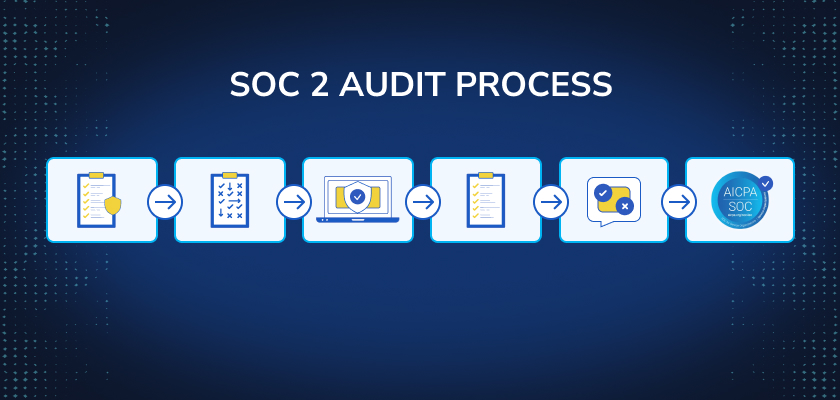
SOC 2 Audit Process: From Prep to Attestation
For MSPs and MSSPs, SOC 2 compliance is more than a security milestone, it’s a business enabler.
The audit is the pivotal stage where your internal controls are reviewed, tested, and documented by an independent auditor. It’s what turns months of preparation into a tangible report you can use to prove trustworthiness, win deals, and scale securely.
This guide breaks down the entire SOC 2 audit process, from pre-audit readiness to final report delivery, so you know exactly what to expect, who needs to be involved, and how to avoid costly missteps.
What Is a SOC 2 Audit?
A SOC 2 audit is a formal, independent evaluation that determines whether your organization’s systems and practices meet the AICPA’s Trust Services Criteria:
- Security (required)
- Availability
- Processing Integrity
- Confidentiality
- Privacy
The outcome is an attestation report that auditors, clients, and procurement teams can rely on to assess your internal controls.
Type I reports assess control design at a specific point in time.
Type II reports evaluate whether those controls were operating effectively over a sustained period (typically 3–12 months).
The SOC 2 Audit Process Explained
Here’s how the full SOC 2 audit process unfolds:
- Pre-Audit Readiness Review
Conduct an internal review, or work with a readiness partner, to identify control gaps and align documentation before the audit begins. - Scoping and Documentation
Define what’s in scope: systems, services, departments, and vendors. Finalize which Trust Services Criteria apply. Security is mandatory; the others are based on your business model and client needs. - Fieldwork and Evidence Collection
The audit team will collect documentation, review system configurations, evaluate logs, and conduct interviews with key personnel. They’ll validate your policies, procedures, and technical safeguards. - Control Evaluation and Testing
- For Type I: The auditor reviews control design only.
- For Type II: Controls are tested for consistent performance over the defined period.
- For Type I: The auditor reviews control design only.
- Remediation (If Needed)
If gaps or deficiencies are identified, you’ll have the opportunity to remediate before final reporting. - Report Drafting and Review
The auditor compiles a comprehensive report including:- Control descriptions
- Tests performed
- Results and exceptions
- Auditor’s opinion (clean, qualified, or adverse)
- Control descriptions
- Attestation and Report Delivery
The completed SOC 2 report is issued and can be used to fulfill vendor due diligence, respond to RFPs, and assure prospective customers.
The MSP Guide to SOC 2: Preparing for a SOC 2 Journey
DownloadKey Stakeholders in the Audit Process
SOC 2 audits require cross-functional involvement:
- Compliance or Security Lead – Orchestrates the process and manages documentation
- DevOps or IT Team – Provides access to system logs, cloud configurations, and technical evidence
- Legal and Leadership – Own risk oversight, incident response, and data privacy policies
- External Auditor – Licensed CPA firm that performs the assessment and issues the official SOC 2 report
Common Challenges in SOC 2 Audits
Avoid these common roadblocks that delay or complicate audits:
- Missing or outdated evidence
(e.g., expired access logs, outdated policy documents) - Unclear control ownership
(No one assigned to key tasks like log review or change approvals) - Weak change management trails
(Missing documentation of code, infrastructure, or configuration changes) - Training and onboarding gaps
(No formal security awareness program or checklist for offboarding former employees)
Proactive readiness and well-documented systems go a long way in ensuring audit success.
FAQs About SOC 2 Audits
The assessment refers to the audit itself, conducted by an independent CPA. A readiness assessment is a pre-audit review you perform internally (or with a tool like Cynomi) to prepare.
Only licensed CPA firms can perform SOC 2 audits and issue formal reports under AICPA guidelines.
SOC 2 Type II reports are typically valid for 12 months. To maintain audit-ready status, organizations undergo annual re-audits.
- Type I: Can be completed in a few weeks, post-readiness
- Type II: Requires a 3–12 month observation period, followed by 2–6 weeks of fieldwork and report preparation